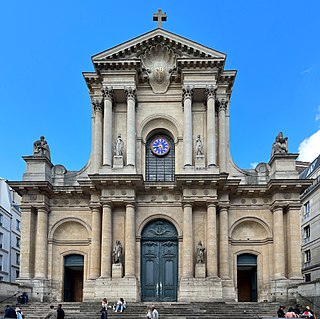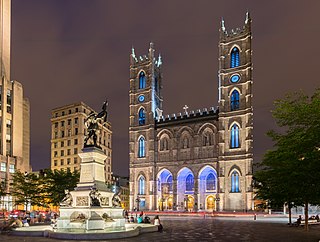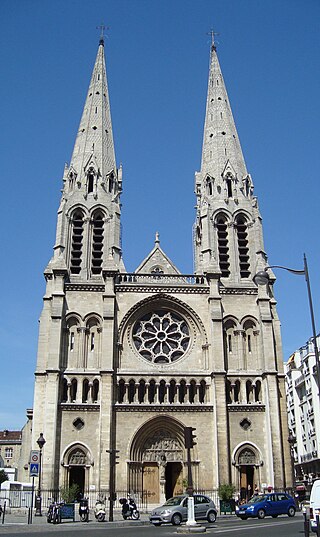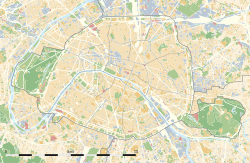
The Basilica of the Sacred Heart in Notre Dame, Indiana, is a Catholic church on the campus of the University of Notre Dame, also serving as the mother church of the Congregation of Holy Cross (C.S.C.) in the United States. The neo-gothic church has 44 large stained glass windows and murals completed over a 17-year period by the Vatican painter Luigi Gregori. The basilica bell tower is 230 feet (70 m) high, making it the tallest university chapel in America. It is a contributing building in Notre Dame's historic district listed on the National Register of Historic Places. The basilica is a major tourist attraction in Northern Indiana, and is visited annually by more than 100,000 tourists.

The Church of St. Eustache, Paris, is a church in the 1st arrondissement of Paris. The present building was built between 1532 and 1633.

The Church of Saint-Germain l'Auxerrois is a medieval Roman Catholic church in the 1st arrondissement of Paris, directly across from the Louvre Palace. It was named for Saint Germanus of Auxerre, a medieval bishop of Auxerre, who became a papal envoy and met Saint Genevieve, the patron saint of Paris, on his journeys. Genevieve is reputed to have converted Queen Clotilde and her husband, French king Clovis I to Christianity at the tomb of Saint Germain in Auxerre.

Saint-Brieuc Cathedral is a Roman Catholic church located in the town of Saint-Brieuc, Brittany, France, and dedicated to Saint Stephen.

Located at 6, rue Notre-Dame-des-Victoires, in the 2nd arrondissement of Paris, The Basilica of Notre-Dame-des-Victoires is one of ten minor basilicas located in the Île-de-France region of France. It was begun as an Abbey church, and constructed between 1629 and 1740 in the French classical style. Its name was given by King Louis XIII, who dedicated it to his victory over the Protestants at La Rochelle in 1628 during the French Wars of Religion. Notre-Dame-des-Victoires is famous for the ex voto offerings left there by the faithful. Over 37,000 devotional plaques, silver and gold hearts, as well as military decorations, have been left at the basilica. The closest Métro station is 'Bourse'.

The Church of Saint-Roch is a 17th–18th-century French Baroque and classical style church in Paris, dedicated to Saint Roch. It is located at 284 rue Saint-Honoré, in the 1st arrondissement. The current church was built between 1653 and 1740.

Notre-Dame Basilica of Montreal is a minor basilica of the Catholic Church in the historic Old Montreal district of Montreal in Quebec, Canada. It is located at 110 Notre-Dame Street West, at the corner of Saint Sulpice Street. It is situated next to the Saint-Sulpice Seminary and faces the Place d'Armes square.

St Francis Xavier Church is a parish Roman Catholic church in the 7th arrondissement of Paris dedicated to Francis Xavier, the patron saint of missions. Built in the late 19th century, It gave its name to the nearby Metro station Saint-François-Xavier. It contains the tomb of Madeleine Sophie Barat, a French saint of the Catholic Church and founder of the Society of the Sacred Heart, a worldwide religious institute of educators. It is also known for its collection of Italian Baroque and Mannerist paintings, including a work by Tintoretto. The church was inscribed as an historic monument in 2018.

The Église Saint-Bonaventure is one of the churches of the quarter Presqu'île, located on the Place des Cordeliers, in the 2nd arrondissement of Lyon. This is the only medieval building not demolished after the creation of the rue Impériale, under the Second Empire by the prefect Claude-Marius Vaïsse.

Notre-Dame-de-Lorette is a Roman Catholic church located in the 9th arrondissement of Paris, It was built between 1823 and 1836 in the Neo-classical architectural style by architect Louis-Hippolyte Lebas, in a neighbourhood known as the New Athens, for its many artistic and scholarly residents in the 19th century, including George Sand, Pierre-Auguste Renoir, and Alexandre Dumas. While the exterior is classical and austere, the church interior is known for its rich collection of paintings, sculpture, and polychrome decoration.
Jean-Marie Duthilleul is a French architect and civil engineer.

Notre-Dame-de-la-Salette is a Roman Catholic church located rue de Cronstadt in the 15th arrondissement of Paris. It is under the patronage of Our Lady of La Salette, particularly revered by the religious congregation of St. Vincent de Paul.

Notre-Dame-de-la-Croix de Ménilmontant is a Roman Catholic parish church located in Ménilmontant, in the 20th arrondissement of Paris, France. It was built between 1863 and 1880. Of exceptional height and length, it is one of the largest churches in Paris.

Notre-Dame-de-l'Assomption is a Roman Catholic church in the First arrondissement of Paris, France, located on Place Maurice-Barrès at the corner of Rue Saint-Honoré and Rue Cambon. It was constructed as a convent church during the reign of Louis XIV between 1670 and 1676 in the Baroque architectural style Since 1844 it has been the main Polish church of Paris. It is known for its collection of Baroque paintings.

Jean-Marie Valentin was a French architect and sculptor specialising in religious furnishings such as pulpits, altars and statues.

Notre-Dame-de-la-Compassion is a Roman Catholic Church located on Place du Général Koenig in the 17th arrondissement in Paris. It was originally built in 1842–43 as a memorial chapel to Ferdinand Philippe, Duke of Orléans, the heir to King Louis-Philippe of France, who was killed in a road accident in 1842. It was built in the Neo-Byzantine style, with elements of Gothic, Baroque and other styles, and was originally called the Chapelle Royale Saint-Ferdinand. In 1970 it was moved stone by stone from its original location a short distance away to make space for the new Palais des Congrès. It became a parish church in 1993. Its notable decoration includes stained glass windows designed by Jean-Auguste-Dominique Ingres, and sculpture by Henri de Triqueti. It was designated a French historic monument in 1929.

Saint-Jean-Baptiste de Belleville is one of the first churches of Neo-Gothic architecture built in Paris. Located at 139 rue de Belleville, in the 19th arrondissement of Paris, it was built between 1854 and 1859.

Notre-Dame de la Gare is a Roman Catholic parish church located on Place Jeanne-d'Arc in the 13th arrondissement of Paris, France. It was built between 1855 and 1864 in an area of Paris which was rapidly industrializing, and was located near the major freight railway station, or "Gare", which gave the church its name. The style was inspired by Romanesque architecture.

Notre-Dame-du-Travail is a Roman Catholic church located at 59 rue Vercingetorix in the 14th arrondissement of Paris. It was built between 1897 and 1902 for the largely working-class population of the Plaisance neighborhood. It is notable particularly for its exposed steel framework in the interior, resembling a factory, in contrast to the more traditional exterior. The entire church was registered as an historic monument on July 5, 2016.



















